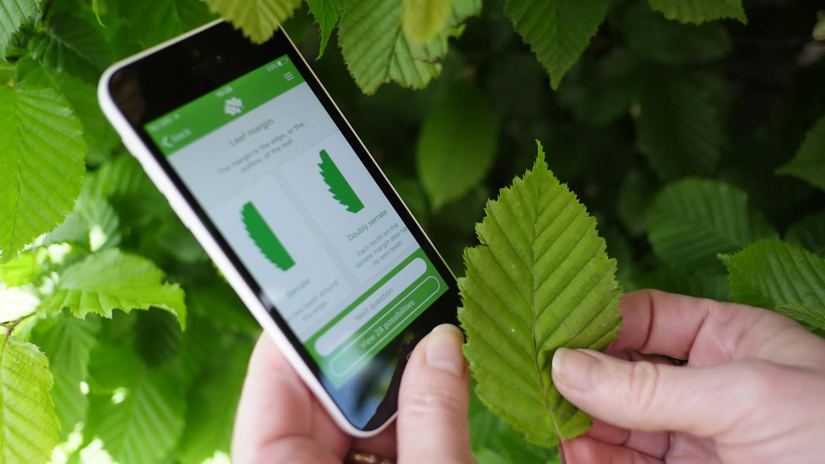
Credit: Nature Photographers Ltd / WTML
Leaves
The brown and pointed leaf buds form on short stalks and have downy hair on their tips. These are followed by glossy, oval leaves which grow to a length of 6cm and have rounded teeth.
A symbol of fertility and a forager's delight. Crab apple trees are associated with love and marriage and its small, hard fruits make an exquisite, jewel-coloured jelly.
Common name: crab apple
Scientific name: Malus sylvestris
Family: Rosaceae
Origin: native
One of the ancestors of the cultivated apple (of which there are more than 6,000 varieties), it can live to up to 100 years. Mature trees grow to around 10m in height. They have an irregular, rounded shape and a wide, spreading canopy. With greyish brown, flecked bark, trees can become quite gnarled and twisted, especially when exposed, and the twigs often develop spines. This 'crabbed' appearance may have influenced its common name, 'crab apple'. The crab apple is one of the few host trees to the parasitic mistletoe, Viscum album, and trees are often covered in lichens.
Look out for: its 'crabbed' or spiny appearance because of gnarled and twisted twigs.
Identified in winter by: the edges of the bud scales which have a short row of hairs.
Crab apples can vary enormously. Although they are the wild ancestors of our commercial apples (a species that varies enormously in its own right), many trees you come across in the wild have grown from domestic apples that have self-seeded, and either reverted to a wild form or crossed with true crabs. The closer they are to the parents, the larger and sweeter their fruit will be.

Credit: Nature Photographers Ltd / WTML
The brown and pointed leaf buds form on short stalks and have downy hair on their tips. These are followed by glossy, oval leaves which grow to a length of 6cm and have rounded teeth.

Credit: Nature Photographers Ltd / WTML
In spring, the sweetly scented blossom is pollinated by bees and other insects. The blossom develops into small, yellow-green apple-like fruits around 2–3cm across.

Credit: Frank Hecker / Alamy Stock Photo
Sometimes the fruits are flushed with red or white spots when ripe. Birds and mammals eat the apples and disperse the seeds.
Other fruit trees in the Rosaceae family when there's no fruit on the tree.

Download our free Tree ID app for Android and iPhone to identify the UK's native and non-native trees. It's an A-Z tree guide in your pocket.
Download the app
Credit: Phil Formby / WTML
Crab apple thrives best in heavy, moist, well-drained soil and areas of scrub. They grow throughout Europe.
The leaves are food for the caterpillars of many moths, including the eyed hawk-moth, green pug, Chinese character and pale tussock. The flowers provide an important source of early pollen and nectar for insects, particularly bees, and the fruit is eaten by birds, including blackbirds, thrushes and crows. Mammals, such as mice, voles, foxes and badgers, also eat crab apple fruit.

Credit: Jane Corey / WTML
Crab apples have long been associated with love and marriage. It was said that if you throw the pips into the fire while saying the name of your love, the love is true if the pips explode. Apple wood was burned by the Celts during fertility rites and festivals, and Shakespeare made reference to crab apples in A Midsummer Night's Dream and Love's Labour Lost.
Crab apple flowers can range from pure white to deep pink and their apples can be red or yellow.
The trees are often planted in commercial orchards as their long flowering period makes them excellent pollination partners for cultivated apples. The fruit can be roasted and served with meat or added to ales or punches. More commonly, it is used to make crab apple jelly and as a natural source of pectin for setting jams.
The pinkish wood has an even texture and makes good quality timber, lending itself particularly well to carving and turning. It also makes a sweetly scented firewood. In Ireland, a yellow dye was extracted from the bark to colour wool.

Helen Keating • 24 Oct 2018
With their terrifically tart and tangy flavour, crab apples are a favourite foraged food.
Get the recipes
Credit: Judith Parry / WTML
The crab apple is susceptible to a variety of fungal infections, including apple scab, honey fungus and apple canker. The bacterial disease fireblight gives them the appearance of being scorched. These threats can easily spread to cultivated apple trees and will eventually reduce the health of the tree.